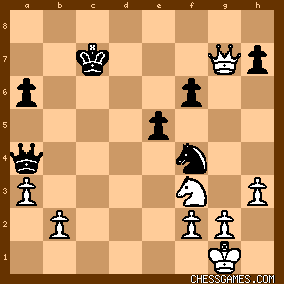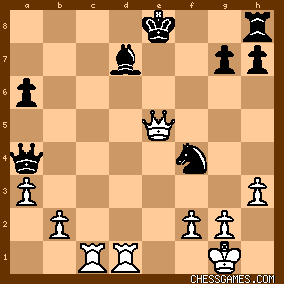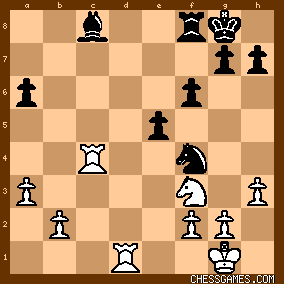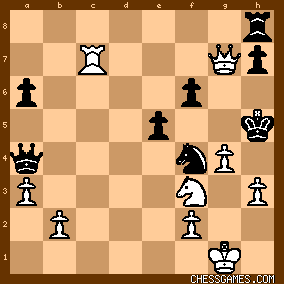|
< Earlier Kibitzing · PAGE 2 OF 2 ·
Later Kibitzing> |
| Feb-20-15 | | Oliveira: <Cheapo> Nice article. Definitely worth the read. |
|
| Feb-20-15 | | ozu: I was so close.. |
|
| Feb-20-15 | | agb2002: White has a rook for a bishop and a pawn.
Black threatens ... Ne2+.
White can start an attack against the black king with tempo, 24.Rd8+: A) 24... Kxd8 25.Qxc7+ Ke8 26.Qxc8+
A.1) 26... Ke7 27.Qb7+
A.1.a) 27... Kd(e)8 28.Rc8#.
A.1.b) 27... Kf8 28.Rc8+ wins.
A.1.c) 27... Ke6 28.Rc6+ Kf5 (28... Kd5 29.Rxa6+ wins the queen) 29.Qd7+ Kg6 (29... Ke4 30.Nd2#; 29... Ne6 30.Qxe6+ and Black loses too much material) 30.Rxf6+ gxf6 31.Qxa4 + - [Q+P vs R]. A.1.d) 27... Kd6 28.Qc7+
A.1.d.i) 28... Ke6 29.Rc6+ Kd5 (29... Kf5 30.Qd7+ transposes to A.1.c) 30.Qd7+ Ke4 31.Nd2#. A.1.d.ii) 28... Kd5 29.Rc5+ Ke4 (29... Ke6 30.Rc6+ transposes to A.1.d.i) 30.Rc4+ wins. A.1.e) 27... Qd7 28.Rc7 wins.
A.2) 26... Kf7 27.Rc7+ Kg6 28.Qg4+ Kh6 29.Qxg7+ Kh5 30.g4#. B) 24... Kf7 25.Qxc7+ Kg6 26.Rxh8 Ne2+ 27.Kh1 Nxc1 28.Qxc1 + - [R+N vs B]. |
|
| Feb-20-15 | | gofer: Looks like a simple rook sacrifice deflecting the king to a square he
just doesn't want to go to...
<24 Rd8+ ...>
24 ... Kf7
25 Rxc7+ Kg6
26 Rxh8 
24 ... Kxd8
25 Qxc7+ Ke8
26 Qxc8+ Ke7 (Kf7 Rc7+  ) )
27 Rc7+ Kd6!
28 Qxh8! Kxc7
29 Qxg7+ 

click for larger viewOkay, so that's one option, but perhaps we can find something
better...
24 Qxc7 ...
White is hoping for...
24 ... Bd7
25 Nxe5! fxe5
26 Qxe5+ ...

click for larger view26 ... Kf7 27 Rxd7+ Qxd7 28 Rc7 
26 ... Kf8 Qb8+ 
26 ... Kd8 27 Re1 
26 ... Be6 27 Rc8+ Ke7/Kf7 28 Rc7+ 
26 ... Ne6 27 Qb8+ Ne8 28 Re1+ 
But perhaps black can castle!!!
24 ... O-O
25 Qc4+ Qxc4
26 Rxc4 

click for larger viewThis also looks like a win and perhaps O-O is not a legal move
for black, in which case, black is losing. But I imagine O-O
is legal and so probably option 1 above the double-rook sacrifice
is the best option...
~~~
Doh! I completely missed 27 Qb7+ which was really the only important line... ...and I should have tried harder to find it given my alternative
was no a clear-cut/definite win... |
|
| Feb-20-15 | | morfishine: From <c5> the White Queen prevents Black from castling (which he would immediately do if White plays 24.Qxc7??). Black's only "threat" is Ne2+ regaining the exchange White has a nice, simple solution
<24.Rd8+> this deflection draws the Black King to <c7> allowing the White Queen to continue checking from that point <24...Kxf7> forced, but it doesn't much matter since White has a forced mate 25.Qxc7+ Ke8 26.Qxc8+ Kf7 27.Rc7+ Kg6 28.Qg4+ Kh6 29.Qxg7+ Kh5 30.g4# 
click for larger view***** |
|
| Feb-20-15 | | diagonalley: has to be 24.R-Q8+ et seq. winning ... easy for a friday :-) |
|
Feb-20-15
 | | Richard Taylor: I saw this R sac quite quickly but I thought 24. b3 was best first but I overlooked 24. ... Qf4. But even then 25. Rxd8+ wins.
That was a good tournament for Grefe to play in! He did well and this was a nice game. I see he was a year older than me, and I sometimes had long hair in 1973 but Grefe was better looking for sure! And I never won a national champs. Good on him, very nicely played game. |
|
Feb-20-15
 | | Richard Taylor: Sad to see he is dead so recently. I wonder what his occupation was. I hope he had a good life overall. He clearly had a flair for combinative play and visualised this attack over the board which is impressive. |
|
| Feb-20-15 | | Lambda: My OTB approach would be to play the first few moves, and think again after Ke7. Worst case, I take the rook, and I'll be immediately two pawns up in a queen and knight endgame with loads of checks. But easier to search for a mate when the position is advanced a bit. |
|
Feb-20-15
 | | Penguincw: 24.Rd8+ was just kinda crying to be played, but I didn't find the followup because I didn't realize c7 was attacked twice. :| |
|
| Feb-20-15 | | Chess Dad: I had the first three moves, but would have chosen 27. Rc7+ and then I would have been hard pressed to find something else after 27... Kd6. |
|
| Feb-20-15 | | Pedro Fernandez: <Morphy>, 24.Qxc7! also wins! |
|
| Feb-20-15 | | dfcx: 24.Rd8+ looks goood
24...Kxd8 25.Qxc7+ Ke8 26.Qxc8+
then Qxh8 wins easily. But there might be a chance to mate?Let's take a look. OK, after 27.Qb7 Black could have played Qd7 and white gets the queen with Rc7, no immediate mate. or he could have played 29...Ke6 to avoid mate as well. |
|
| Feb-20-15 | | dfcx: woops, I missed the black's counter play if 27.Qxh8 Ne2+ wins back the rook. I only get half of the credit. |
|
| Feb-20-15 | | patzer2: Here's my look at the game and the Friday puzzle position (i.e. 24. ?) with the Opening Explorer and Fritz 12: <6...Ne7> Not a fan of this move. My preference is 6... Bg4! = to  as in K Rogoff vs Reshevsky, 1974 as in K Rogoff vs Reshevsky, 1974 <17...Rb4?> This seems to be the decisive error. Instead, Black should try 17... O-O 18. Nxc5 Nf4 19. h3 Ne6 20. Nxe6 Bxe6 21. b3 Rfd8 22. Kh2  when he's only a pawn down but still has counter play and drawing chances. when he's only a pawn down but still has counter play and drawing chances. <24. Rd8+!> This rather obvious try, which was my quick choice, solves our Wednesday puzzle. But it's not the only winning move. White also wins with the simple 24. Qxc7 when play might continue 24...O-O 25. Rd8!Ne2+ (25... Rxd8 26. Qxd8+ Kf7
27. Rxc8  ) 26. Kh1 Nxc1 27. Rxf8+ Kxf8 28. Qxc8+ Kf7 29. Qxc1 ) 26. Kh1 Nxc1 27. Rxf8+ Kxf8 28. Qxc8+ Kf7 29. Qxc1  . . <24...Kxd8 25. Qxc7+ Ke8 26. Qxc8+ Ke7 27. Qb7+!!> This move, preparing a clever King hunt, wins with flash. But it's difficult. However, White can also win with the slightly easier 27. Qxh8 Ne2+ 28. Kh2 Nxc1 29. Qxg7+  when play might continue 29...Ke6 30. Qg8+ Kd7 (30... Kf5 31. b4! h5 32. Nh4+ Kf4 33. g3+ Ke4 34. Qc4#) 31. Qxh7+ Kd6 32. b4! Qxa3 33. Qf7 Qa2 34. Qf8+ Kc7 35. Qc5+ Kd7 36. Qxc1 when play might continue 29...Ke6 30. Qg8+ Kd7 (30... Kf5 31. b4! h5 32. Nh4+ Kf4 33. g3+ Ke4 34. Qc4#) 31. Qxh7+ Kd6 32. b4! Qxa3 33. Qf7 Qa2 34. Qf8+ Kc7 35. Qc5+ Kd7 36. Qxc1  . . <27... Kd6>
If 27... Ke6, then it's mate after 28. Rc6+ Kf5 29. g4+ Kg6 30. Nh4+ Kg5 31. Qxg7+ Ng6 (31... Kxh4 32. Qh6+ Nh5 33. Qxh5#) 32. Qxf6+ Kh6 33. Nf5#. <28. Qc7+ Kd5>
If 28... Ke6, then White spins the mating web again with 29. Rc6+ Kf5 30. Qd7+ Kg6 (30... Ke4 31. Nd2#) 31. Qg4+ Kf7 (31... Kh6 32. Qg5# ) 32. Nxe5+ Kf8 (32... fxe5 33. Qd7+ Kf8 34. Rc8#; 32... Kg8 33. Qc8#) 33. Qc8+ Ke7 34. Qd7+ Kf8 35. Rc8#. <29. Rc5+ Ke6 30. Rc6+ 1-0> Black resigns in lieu of 30...Kf5 31. Qd7+ Kg6 (31... Ke4 32. Nd2#) 32. Qg4+ Kf7 (32... Kh6 33. Qg5#) 33. Nxe5+ Kf8 (33... Kg8 34. Qc8#; 33... Ke7 34. Qd7+ Kf8 35. Rc8#; 33... Ke8 34. Qd7+ Kf8 35. Rc8#) 34. Qc8+ Ke7 35. Qd7+ Kf8 36. Rc8#. |
|
| Feb-20-15 | | pedro99: I'm with chrisowen on this one |
|
| Feb-20-15 | | Longview: <ozu> I agree, it is hard to keep all of this in your head at once. I did get this one for once though I thought the Black king would tty to escape through the 26... Kf7 27 Rc7+ Kg6 route where mate would come after Qg4 Kh6 Qxg7 kh5 g4# I saw the capture of the Bishop and pawn for the rook with chances to regain the Rook and become even in pieces but I did not see it through to see the game position to get to the Black Queen being lost. I would have brought my rook down too early and gotten in my own way. 26....Ke7 27. Rd7 instead of Qb7, a move I did not see. That would have lost the other rook and forced Qxh8 and made it more difficult for white. |
|
| Feb-20-15 | | AvidChessMan: I saw it as sacrifice the rook to expose the black king first, then have faith that white queen can finish the job. I was not 100% sure that it would work, but the reward seemed to outweighed the risk. I would not call it blind faith ... perhaps its instinctive faith? |
|
| Feb-20-15 | | Edeltalent: 24.? White to play
Even without a direct combination, White is clearly better. He's an exchange for a pawn up and has active pieces, while the black king is still in the middle of the board. If Black could bring his knight to e6, king to f7 and rook to e8, he could offer some resistance, but 24.Rd8+ deprieves him of all chances to consolidate. The line is forced until 24...Kxd8 25.Qxc7+ Kd8 26.Qxc8+ Ke7. (If 26...Kf7 27.Rc7+ Kg6 28.Qg4+ mates.) Because of the fork on e2, White shouldn't take the rook now, but instead keep checking. One possibility is 27.Rc7+ Kd6 28.Qb7, and with equal material, the huge difference in king safety should soon tell. However, White can also continue more forcing with 27.Qb7+ (it's important to choose this square and not c7 to get the best coordination between queen and rook). The queen can't interpose because of Rc7, and the king can't retreat to the back rank because of Rc8+. If 27...Ke6, 28.Rc6+ Kf5 (28...Kd5 29.Qd7+ Ke4 30.Nd2#) 29.Nh4+ Kg5 (29...Ke4 30.Rc4+) 30.Qxg7+ Ng6 31.Qxf6+ and it's over. If 27...Kd6, 28.Qc7+ Ke6 29.Rc6+ is similar, and 28...Kd5 29.Rc5+ Ke4 30.Rc4+ also not difficult any more. A pretty depressing puzzle for the black King, who is bullied by checks from start to finish. It looks like he is bullet dancing. |
|
| Feb-20-15 | | TheaN: Friday 20 February 2015 <24.?> White is up the exchange for a pawn. Black probably hopes on white playing 24.Qxc7 after which black can still create a game by playing 24....O-O. Instead, white seeks to disrupt black's king safety by returning the exchange momentarily: <24.Rd8+!> declining the sac will just cost a rook. <24....Kxd8 25.Qxc7+> the point is that now, this move is with tempo, and black can't castle. <25....Ke8 26.Qxc8+> so far this whole combination was forced. In fact, <26....Ke7> is also forced, as 26....Kf7? 27.Rc7+ Kg6 28.Qg4+ Kh6 29.Qxg7+ Kh5 30.g4#. Now white has a choice. The simple 27.Qxh8?! meets Ne2+ with Nxc1, after which white has the initiative but material is even after Qxg7+. 27.Rc7+!? seems killing, but after 27....Kd6! black controls all crucial squares around the king, and 28.Qxh8 Kxc7 29.Qxg7+ does lead to clear advantage for white but these endings can be hard to win. Is there anything better? My eye dropped on <27.Qb7+!>. White loses scope on the rook on h8, but this is actually the piece with the least influence on the board. Qb7 clears the c-file for the white rook and has tabs on e4, which could be crucial for a mating attack. A) <27....Kd8/Ke8? 28.Rc8# 1-0> B) <27....Kf8? 28.Rc8+ Qe8+ 29.Rxe8+ Kxe8 30.Qc8+  > and the rook falls too, with mate soon. > and the rook falls too, with mate soon. C) <27....Qd7? 28.Rc7! Rd8 29.Qb4+  > and white wins queen for rook. > and white wins queen for rook. Kd6 and Ke6 test white the most:
D) <27....Ke6 28.Rc6+ Kf5 (Kd5 29.Qd7+ Ke4 30.Nd2#) 29.Qd7+ Kg6> if 29....Ke4 30.Nd2# and if 29....Ne6 30.Qxe6+  with Nxe5+ and mate soon. White can now win with Rxf6+!? with Nxe5+ and mate soon. White can now win with Rxf6+!?  , but <30.Nxe5+! Kh6 (Kg5/Kh5 31.Qg4+ Kh6 32.Nf7#) 31.Nf7+ Kg6 (else Qg4#) 32.Qg4+! Kxf7 33.Rc7+> queen and rook switched relative places: <33....Kf8 (Ke8 34.Qc8#) 34.Qxg7+ Ke8 35.Qe7#>. , but <30.Nxe5+! Kh6 (Kg5/Kh5 31.Qg4+ Kh6 32.Nf7#) 31.Nf7+ Kg6 (else Qg4#) 32.Qg4+! Kxf7 33.Rc7+> queen and rook switched relative places: <33....Kf8 (Ke8 34.Qc8#) 34.Qxg7+ Ke8 35.Qe7#>. E) <27....Kd6> controls c6 <28.Qc7+ Kd5> 28....Ke6 29.Rc6+ leads to variation D <29.Rc5+ Ke4> Ke6 leads again to Rc6+ and variation D <30.Rc4+  > and now it's truly over. > and now it's truly over. Verdict, 27.Qb7+ is superior and wins. |
|
| Feb-20-15 | | TheaN: Not all my variations are the most optimal (in D after 28...Kf5 29.g4+! mates quicker for example) but the principles of the posted variations are all correct. |
|
| Feb-20-15 | | Cheapo by the Dozen: <Oliveira>,
Glad you liked the article!
And you're right about castling. That said, I wouldn't like to defend Black's endgame, down the exchange for no compensation. |
|
| Feb-20-15 | | thegoodanarchist: As I played over this game, a voice in my head kept saying to Black "You should castle!" Move after move, until it was too late.... |
|
| Feb-20-15 | | TheBish: J Grefe vs A Karklins, 1973 White to play (24.?) "Difficult"
This is a nice one which should be known to many, especially fans of great American players. John Grefe is one of my favorite players, who has played some great dynamic games full of tactics. I remember when I was young, I saw an old 1973 copy of Chess Life with an article by Grefe, titled "Can an Apple Picker Win the U.S. Championship?" or something very similar. He had been working as an apple picker in Washington or Oregon, forgot which but I'm thinking Washington. Anyway, he won the U.S. title that year with Kavalek, and I believe this was one of the games from the Championship. 24. Rd8+! Kxd8
Obviously forced, otherwise White wins the rook for an easy win. 25. Qxc7+ Ke8 26. Qxc8+ Ke7
Or 26...Kf7 27. Rc7+ Kg6 28. Qg4+ Kh6 29. Qxg7+ Kh5 30. g4#. 27. Qb7+!
Eschewing the rook in favor of the king or queen.
27...Kd6 28. Qc7+ Kd5 29. Rc5+ Ke6
Or 29...Ke4 30. Rc4+ winning the queen.
30. Rc6+ Kf5
Black gets mated after 30...Kd5 31. Qd7+ Ke4 32. Nd2#. 31. Qd7+ Kg6 32. Qg4+ Kf7
Or 32...Kh6 33. Qg5#!
33. Nxe5+! with mate to follow, e.g. 33...Kf8 (33...fxe5 34. Qe6+ Kf8 35. Rc8+ etc.) 34. Qb7+ and mate next move. |
|
| Feb-21-15 | | Abdel Irada: <I would not call it blind faith ... perhaps its instinctive faith?> This sort of intuitive faith is one of the few faculties we have that computers don't. When I beat Fritz, it's usually because of something like this. Of course the computer can calculate circles around me: If there's a line that ends in a clearly calculable disadvantage, the program alertly avoids it. But sometimes it overlooks positional sacrifices whose payoff lies outside its ply depth. Two days ago, for example, I sacced a whole rook without making any attempt to calculate how I'd get it back or find compensation; I simply *knew* that the long diagonal against Fritz' king was going to be a deadly weapon, and that sooner or later I'd find a way to convert. Not blind faith, but faith guided by experience and positional understanding. Sure enough, Fritz had to give up everything to stop mate, and resigned a few moves later. And how did it evaluate the line? Right after the sac, it showed -4.68; five forced moves later, the evaluation had changed to +8.82. ∞ |
|
 |
|
< Earlier Kibitzing · PAGE 2 OF 2 ·
Later Kibitzing> |





